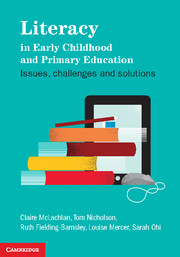Book contents
- Frontmatter
- Contents
- List of figures
- List of tables
- About the authors
- Acknowledgements
- Chapter 1 Introduction
- Part 1 Literacy acquisition: the child, the family and diversity in the modern world
- Part 2 Learning about literacy in early childhood settings
- Part 3 Literacy learning in the primary school
- Part 4 Literacy learning in the senior primary school
- References
- Index
Chapter 1 - Introduction
- Frontmatter
- Contents
- List of figures
- List of tables
- About the authors
- Acknowledgements
- Chapter 1 Introduction
- Part 1 Literacy acquisition: the child, the family and diversity in the modern world
- Part 2 Learning about literacy in early childhood settings
- Part 3 Literacy learning in the primary school
- Part 4 Literacy learning in the senior primary school
- References
- Index
Summary
Chapter objectives
To explore the reasons for writing this book.
To identify key principles of the theoretical framework.
To explain key points of each chapter.
To provide a framework for readers to follow.
To begin, we introduce you to some scenarios which we consider are not far from the realities that teachers will face in early childhood centres and classrooms.
This introductory chapter provides an overview of the theoretical position adopted in this text and of the content of the chapters that follow. The chapter introduces the myths surrounding reading acquisition and the effectiveness of common pedagogies in early childhood and primary education. It also suggests ways the text can be approached by early childhood and primary pre-service teacher education students and their lecturers.
To begin, we introduce you to some scenarios which we consider are not far from the realities that teachers will face in early childhood centres and classrooms.
Scenario 1.1
You have a four-year-old boy in your early childhood classroom and you are wondering how well he will make the transition to school. Currently he spends most of his time outside in the sandpit, riding bikes or climbing things and seems to enjoy himself, but he rarely spends any time in the centre doing literacy-related activities and he wriggles constantly at mat session times and has to be told to pay attention.
Scenario 1.2
You have a fi ve-year-old girl in your new-entrant class who can clearly already read. When asked what she likes to read at home, she names books that most children are reading at the age of 10. Recent testing reveals that not only can she read the words in the chapter books she likes, but she also has excellent comprehension of what she is reading.
- Type
- Chapter
- Information
- Literacy in Early Childhood and Primary EducationIssues, Challenges, Solutions, pp. 1 - 16Publisher: Cambridge University PressPrint publication year: 2012



